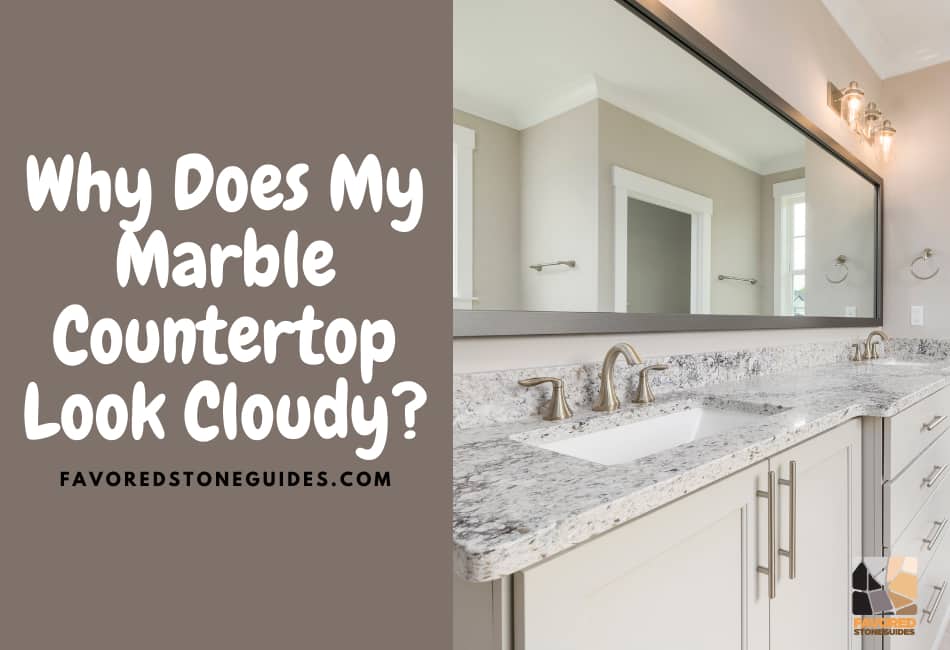If your marble countertop has turned cloudy, you’re not alone. Unfortunately, this is a common issue. In this article, we will discuss all the major causes of cloudiness on marble countertops and how you can fix it.
There are several reasons why your marble countertop might become cloudy. The most common cause is that the sealant has worn off, allowing dirt and grime to penetrate the surface. If this is the case, you will need to reseal the countertop.
Continue reading as I share with you other ways marble countertops can become cloudy and how to fix each one.
1. Using Too Much Alkaline Cleaning Products
Alkaline cleaning products are great for breaking down grease and grime. However, if you use too much of it or leave it on the surface for too long, it can cause the marble to become cloudy or hazy.
This is a lot more common as many household cleaners and dish soaps are alkaline-based. So it’s usually hard to tell if you’re using too much.
The best way to clean marble countertops is to use cleaners specially made for marble or a pH-neutral all-purpose cleaner.
Wipe down the countertop with a damp cloth after cleaning to remove any residual cleaner.
2. Lack Of Sealing
Another common cause of cloudiness on marble countertops is a lack of sealing. Marble is a porous natural stone and needs to be sealed to prevent stains and other damage.
Sealing also protects the countertop from etching caused by acidic foods and liquids.
If your countertop is not sealed, it’s highly likely that it will become cloudy or stained over time. This is because the unsealed surface will allow dirt, grime, and liquids to penetrate the marble.
To prevent this from happening, make sure to seal your marble countertop every six months to a year. You can do this yourself or hire a professional.
If your countertop is already stained or cloudy, you can try deep cleaning it a few times to see if that removes the stains and the haze, and then seal it.
A product like Supreme Surface Marble Cleaner, Polish, and Sealer will do an awesome job of deep cleaning, polishing, and sealing your countertop all in one.
3. Not Properly Sealing It
In addition to not sealing your marble countertops at all, not properly sealing it is also a common cause of cloudiness and stains.
When you seal your marble countertop, make sure to use a high-quality sealer made specifically for marble. Also, follow the manufacturer’s instructions on how often to reseal.
Most quality sealers will last up to three years. However, depending on how often you use your countertop and what type of activities take place on it, you may need to reseal more or less often.
If you’re not sure if your countertop is properly sealed, try doing a water test. Place a few drops of water on the surface and wait a few minutes. If the water beads up, your countertop is properly sealed. If the water soaks in, it needs to be resealed.
Even if your countertop is properly sealed, it’s still a good idea to clean up spills as soon as they happen. Acidic liquids like citrus juice, vinegar, and wine can cause etching on marble even if the surface is sealed.
To clean up spills, blot the area with a clean cloth or paper towel and then wipe it down with a damp cloth.
For tough stains, you can try using a poultice. A poultice is a paste made from equal parts flour and water (or another absorbent material) that you apply to the stain and cover with plastic wrap.
Let the poultice sit on the stain for 24 to 48 hours before removing it and wiping down the area with a damp cloth.
A poultice can also be used to remove oil-based stains like makeup, food grease, and handprints. You will need to use a poultice made from fuller earth clay and water for these types of stains.
4. Oil Spill Or Grease Build Up
If you have a marble countertop in your kitchen, chances are you’ve had an oil spill or two.
Oil and grease can build up on the surface of the marble and cause it to become cloudy. This is very common on countertops that are used for cooking.
The constant steam and oil residue that settles on the surface of your marble countertops can eventually cause a haze to form.
This is can be difficult to deal with if you do not clean your marble countertops regularly. If you want to prevent this from happening, you need to get into the habit of regularly cleaning your countertops with a quality marble cleaner.
5. Using Wrong Cleaning Methods
It is not enough to get the right cleaning products, you also need to use the right cleaning methods.
For example, never use abrasive cleaners or scrub pads on your marble countertops, as this will damage the surface. Instead, opt for a non-abrasive cleaner that is specifically made for marble.
A good example is using microfiber cloths or lambswool pads instead of scrubbing the surface with a sponge.
Another common mistake is using too much water when cleaning marble countertops. This can cause the marble to absorb the water and become stained.
When cleaning your countertops, use a damp or stone-safe cleaner and then dry it off with a clean, dry cloth.
6. Etching
Etching is the most common cause of marble countertops looking cloudy. Etching happens when acidic liquids come into contact with the surface of the marble and cause a chemical reaction.
This reaction causes the marble to become dull and gives it a cloudy appearance. This can be caused by things like harsh cleaners, acidic spills like drinks, and even everyday items like lemons and limes.
The best way to prevent etching is to clean up spills as soon as they happen and to use a quality sealer on your marble countertops.
If your countertop is already etched, you can try polishing it with a marble polishing powder. This will help to restore the shine to your countertop and make it look new again.
7. Water Spots
According to the Marble Institute of America, water spots are the number one cause of marble countertops looking cloudy.
Water spots happen when water droplets sit on the surface of the marble for too long and then evaporate. This leaves behind a mineral deposit that can dull the surface of the marble.
This is a lot common in homes with hard water. The best way to prevent water spots is to wipe up spills as soon as they happen and to dry the surface of your countertop with a clean, dry cloth.
If you already have water spots on your countertop, you can try removing them with a glass cleaner or white vinegar.
8. Dulling From Use
You know what, sometimes your marble countertops just need a good cleaning. This is because, over time, the surface of the marble can become dull from use.
If you have had your marble countetop for a while this can be normal. However, the best way to clean a dull countertop is to use a marble polishing powder.
You can also try using a glass cleaner or white vinegar. Finally, if your countertop is really dull, you may need to have it professionally polished.
9. Soap Scum Buildup
If you have a marble countertop in your bathroom, then you probably have to deal with soap scum.
Soap scum is the film that is left behind from using bar soap. It can build up on the surface of your countertop and make it look cloudy.
As I mentioned, it is common on bathroom countertops but can also happen in kitchens if you use liquid soap.
The best way to prevent soap scum is to use a squeegee after every shower and to wipe down your countertop with a damp cloth after using liquid soap.
If you already have soap scum on your countertop, you can try removing it with a stone-safe cleaner.
Usually, it will take more than one cleaning to remove all of the soap scum.
Final Thoughts
These are just a few of the most common causes of marble countertops looking cloudy.
If you are having trouble getting your countertop to look shiny and new again, then you may need to consult a professional.
They will be able to help you figure out what is causing the problem and how to fix it. Thanks for reading! I hope this article was helpful.

